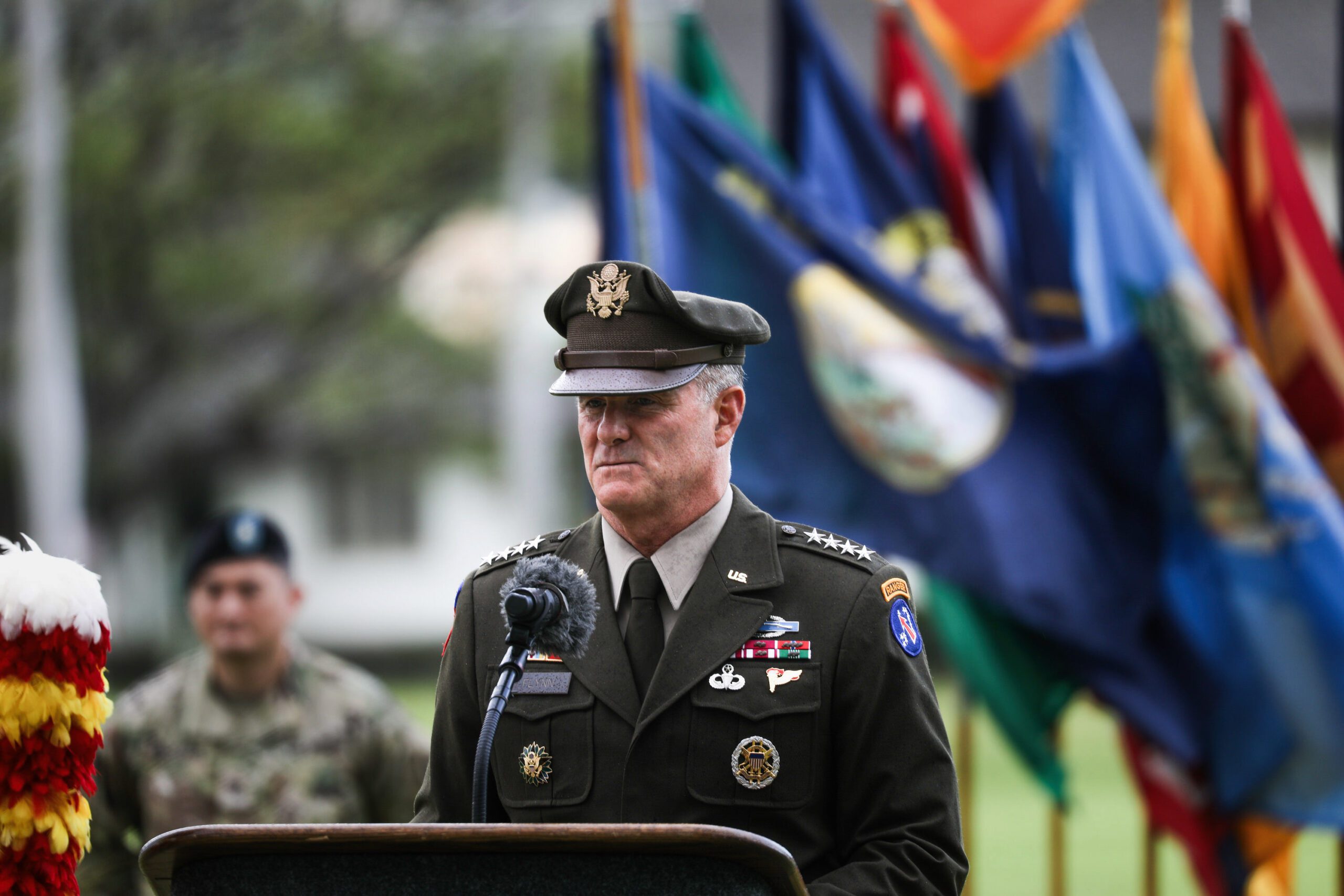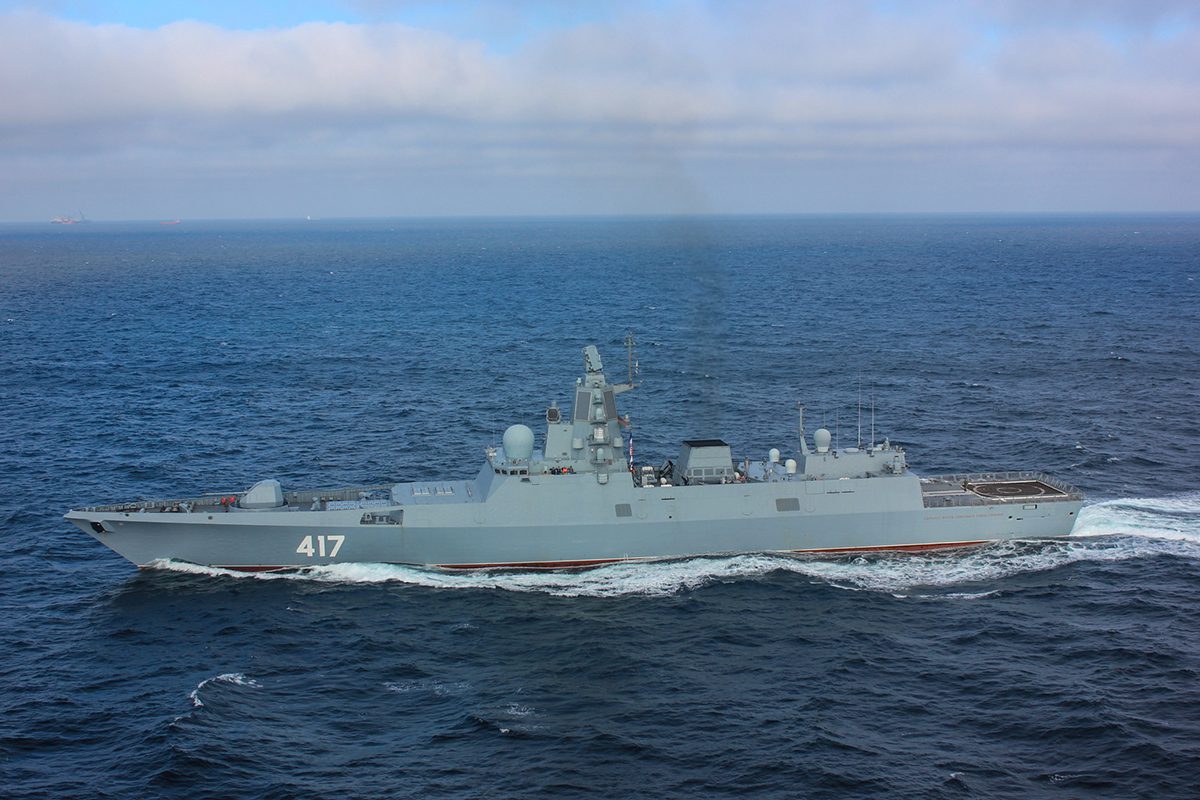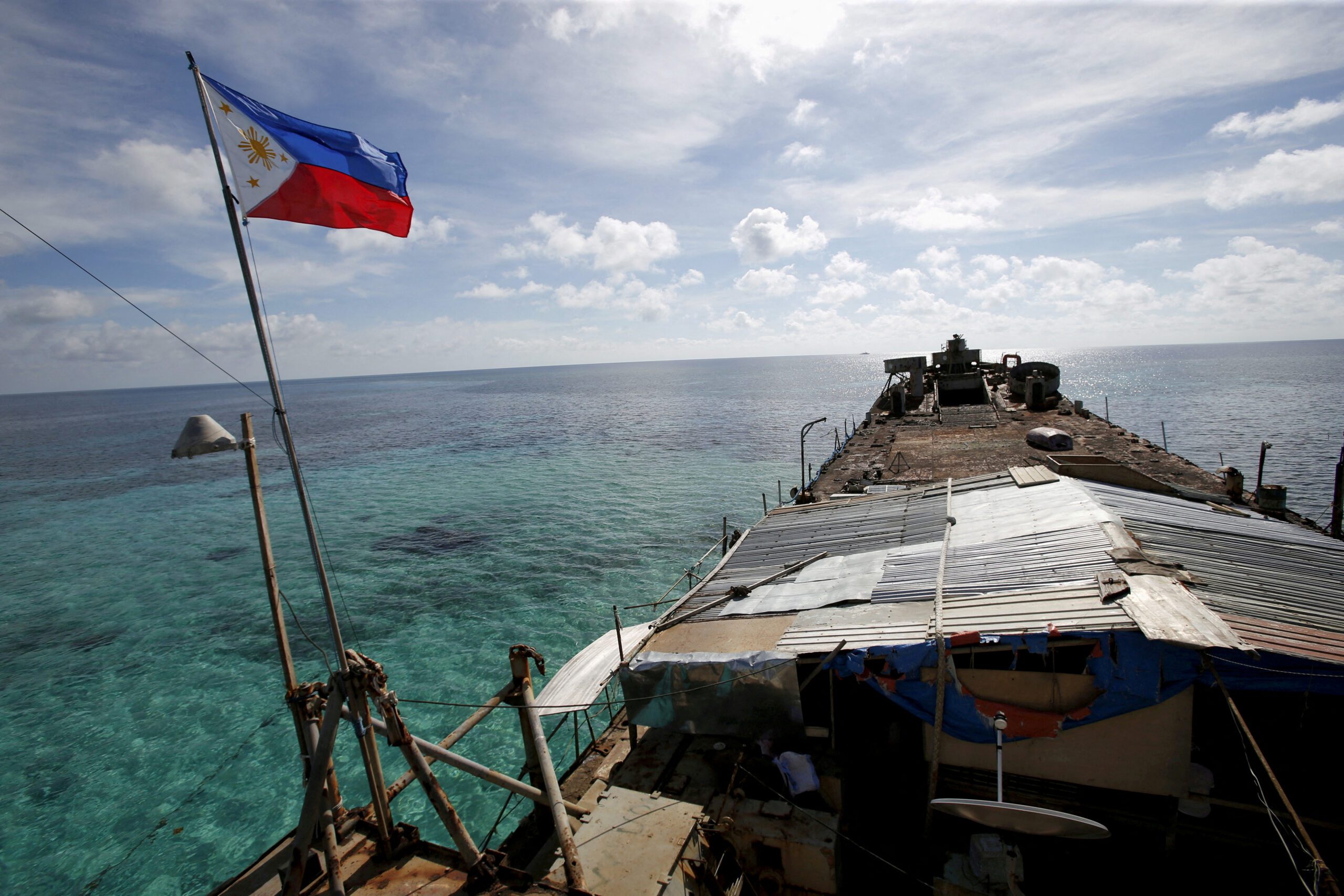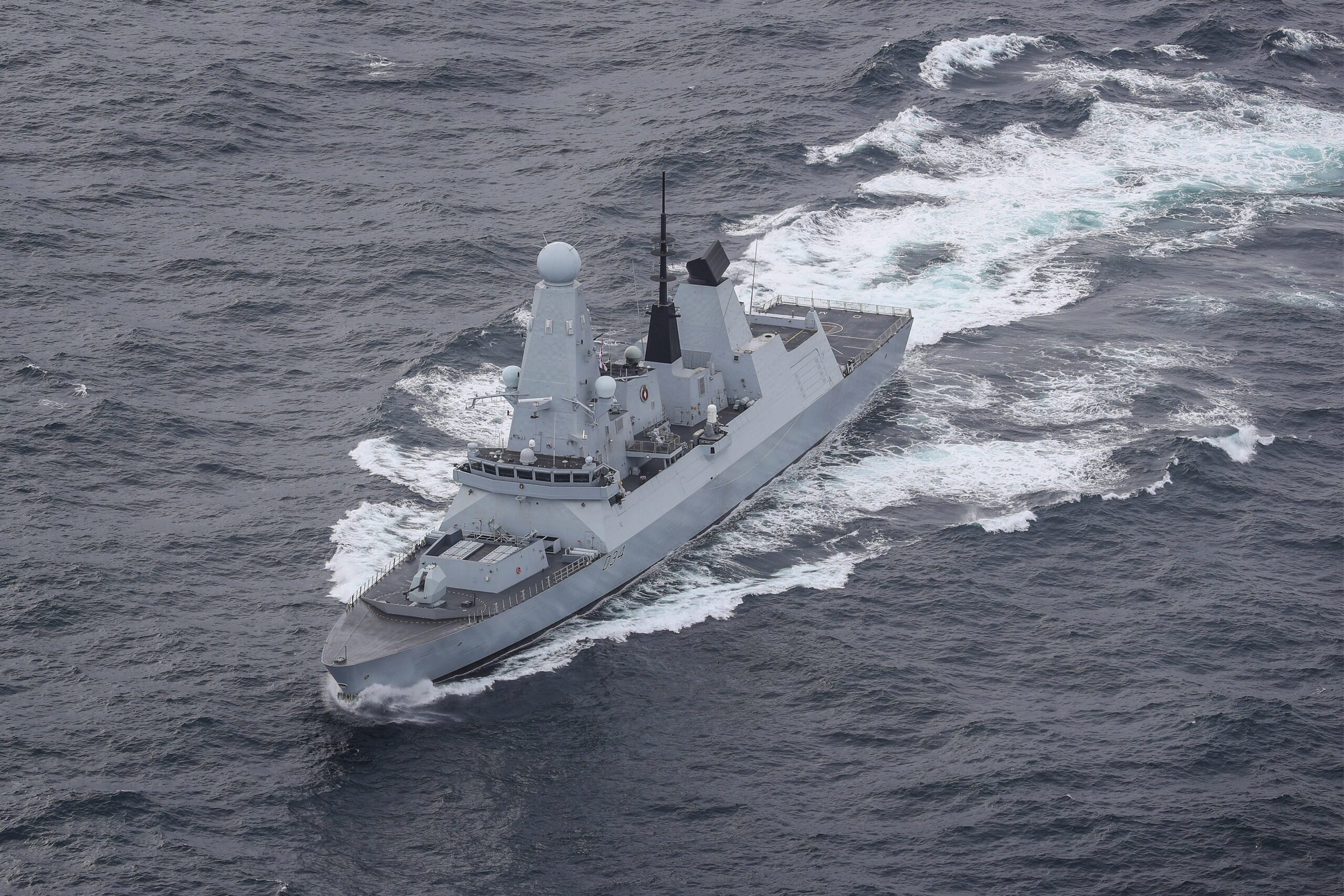by Captain John Konrad (gCaptain Op-Ed) In a viral video with over 200,000 views on X, General Charles Flynn, a 4-star Army commander in the Pacific and brother of former Trump national security advisor Michael Flynn, delivered a passionate yet misguided speech on the primacy of the Army in the Pacific theater – a strategy his command has been calling lynchpin – where he told seapower strategists to “zip-it“. As he leaned into the camera, his words dripped with the fervor of a man defending a bygone era of military dominance, oblivious to the evolving realities of modern warfare in the maritime domain.
Flynn’s assertion that the Pacific is an “Army theater” because it’s labeled as a “joint operation” is laughable. The notion that artillery and ground forces could effectively dominate a region spanning 60 million square miles of ocean is a strategic fantasy. It’s as if the battles of Midway, Coral Sea, and Leyte Gulf never happened—battles that decisively showcased the indispensability of naval and air power in the Pacific.
His rhetoric ignores the sobering realities of recent Army failures in the maritime domain. The Army’s decision to divest from watercraft capabilities, the alarming age and inefficiency of their Corps of Engineers ships, the fact the Corps resorted on heavy US Coast Guard and civilian contractor support to clear the Baltimore Bridge, the embarrassing collapse of the JLOTS pier in Gaza, and their plans to divest Army prepositioning ships all point to a service struggling to maintain relevance in an increasingly maritime-centric world.
Let’s break down Flynn’s delusions. He suggests that the Army can seamlessly coordinate with the militaries of island nations—countries that prioritize land forces due to economic constraints and rely on American naval power for protection. This overlooks the fundamental reason for their reliance on ground troops: they lack the resources to maintain a formidable navy or air force. Flynn’s vision of a land-centric war in the Pacific dismisses the critical roles of the Navy, Air Force, Marines, Coast Guard, and Merchant Marine.
In the event of a conflict with China, the logistics of moving and sustaining Army equipment across vast oceanic distances would necessitate a robust naval and air presence. Flynn’s dismissive attitude towards these branches undermines the essence of joint operations. Jointness doesn’t mean sidelining the Navy and Air Force; it means leveraging the unique strengths of each service to create a cohesive and effective force.
In this context, the Army’s claim of being a pivotal joint logistics facilitator is undermined by the current condition of the U.S. sealift capabilities. As noted by Air Force General Jacqueline D. Van Ovost, the TransCom commander, the United States is “alarmingly behind in modernizing a viable sealift fleet to achieve our national goals.” Additionally, the deteriorating and diminishing Ready Reserve Force faces a critical shortage, lacking 1,800 mariners required to staff its ships.
This isn’t merely about joint operations. It’s about asserting what Flynn believes is the Army’s rightful dominance in the Department of Defense budget and influence. If the focus was on inter-service cooperation for victory, the General would have incorporated the US Coast Guard, US Merchant Marine, and US Space Force into his discourse. Notably, he only called attention to the US Navy and US Air Force, the two services that compete with him directly for control.
This begs the question, is his rant really about working jointly or is it about inter-service rivalry and maintain Army influence and control?
Also read: “West Point Mafia” Has “Systematically Destroyed The Nation’s Maritime Strength”
The Pacific theater is inherently a maritime domain. The Army’s recent track record—highlighted by their divestment from watercraft, reliance on antiquated Corps of Engineer ships, the Gaza pier debacle and defunding of the Army prepositioning fleet —shows a disturbing trend of Army unpreparedness for the realities of a maritime conflict. Flynn’s comments reveal a dangerous ignorance of these facts. It’s not just about inter-service rivalry; it’s about recognizing the strategic and operational necessities that dictate the composition of our forces in the Pacific.
Also read: U.S. Army Watercraft: Lost at Sea -Opinion by CW4 MICHAEL W. CARR, US Army (Retired)
Moreover, Flynn’s narrow interpretation of “joint operations” to mean collaboration with foreign armies, while excluding the primacy of naval and marine forces, is a gross misrepresentation. This perspective is not only strategically flawed but also politically motivated, aiming to secure a larger share of the defense budget for the Army at the expense of other branches.
In another video clip from the same talk, he discusses how allied military services in the region are predominantly Army. However, he omits that many lack naval strength due to budget constraints, making them reliant on assistance from the US Navy. He also neglects to mention that in the event of war, it’s sealift operations that will connect and resupply these allies.
The reality is stark: the Pacific conflict, if it comes to pass, will require a diverse and integrated approach. It will demand the mobility and firepower of the Navy, the reach and precision of the Air Force, the versatility of the Marines, the reach of the Coast Guard, and the logistical backbone of the Merchant Marine. Flynn’s vision of an Army-dominated theater is not only impractical but also dangerous.
How Did The Army Gain So Much Influence?
In the high-stakes world of military operations, the paradoxical dynamics of success and failure starkly differ from the commercial sector. While commercial success is rewarded with promotions and efficiency, the military operates on a contrasting principle: critical failures attract more support and resources. This editorial explores this phenomenon, drawing parallels between a cinematic scenario from “Dog Day Afternoon” and real-world military strategies. Unlike in the private sector, where repeated failures lead to dismissal, in military contexts, failure often attracts additional funding, political influence, and strategic attention.
Aboard commercial ships, we had a saying: “The reward for good work is more work.” Success, defined by achieving more with fewer resources, leads to promotions and increased budgets. Repeated failures, however, result in dismissal. The military does the opposite. Called in only when all other options have failed, failure is not an option. Thus, money, resources, and influence flood to support whoever is failing the most. This is problematic because it is the Army, which has faced the most significant failures over the past two decades, resulting in disproportionate influence in D.C.
Consider Al Pacino in “Dog Day Afternoon.” He robs a bank and easily overcomes the security guards; all is well, but then the police are called about suspicious activity at the bank, and a squad is dispatched. Al isn’t worried because it’s just one cop. That cop tries to convince him to leave but fails, so more cops show up. A negotiator is called but fails, so the SWAT team is notified. The SWAT team botches the entry, so the FBI is called. They fail too. Eventually, many city blocks are walled off, snipers are put on roofs, and helicopters swarm overhead. Eventually, they shoot Al’s best friend, and he gives up.
In high-stakes operations where failure is not an option, such as thwarting bank robberies or military maneuvers in Iraq, escalation provides rewards for failure.
The Global War on Terror – fought mostly a land wars in Asia – has seen no shortage of epic failures and took over 20 years to play out. According to Brown University’s Watson Center, over $8 trillion was spent, so very few resources were held back. The Navy and US Coast Guard played critical roles in the war. Fears of dirty bombs in shipping containers led to new maritime security regulations, ships with links to terrorists were boarded, massive amounts of equipment aboard US Merchant Ships were escorted to Iraq, Piracy exploded around Somalia, and the Navy SEALs played a critical role throughout. But the maritime services didn’t experience many failures. They were largely successful.
The Air Force and Army did fail. Extensive USAF bombing campaigns failed to dislodge Saddam Hussein and terrorist cells in Afghanistan, so the Army was called in. Faced with ineffective body armor and equipment that failed to protect against IEDs, the Army was flooded with money to replace equipment. That problem was mostly solved, but larger problems began snowballing until ISIS rolled over the region. Throughout all this, the checks and resources flooded into Army and Air Force projects.
But it wasn’t just money; it was political influence too. While Navy admirals like Admiral Stavridis were doing exceptional work in NATO and ending piracy off the coast of Somalia, the world took little notice. Meanwhile, CENTCOM commanders who repeatedly failed—men like David Petraeus, James Mattis, and Lloyd Austin—became household names.
Again, in high-stakes operations where failure is not an option, such as thwarting bank robberies or military maneuvers in Iraq, escalation provides rewards for failure.
At the same time, something else started to happen. The US Military is, for reasons of tradition and necessity, a secret and semi-clandestine organization. In the commercial world, companies and organizations that embrace transparency and truth gain the support of customers. In the Navy, however, every Annapolis midshipman is taught that loose lips sink ships. Neither Petraeus, Mattis, nor Austin wanted to be outright and honest—Petraeus’ personal secrecy eventually cost him his job—but after so many failures mounted, the pressure became so intense from the media and Congress that they had no choice but to be honest and forthright with answers.
And strangely, this honesty was appreciated by a public that was confused and frustrated by all the failures. Many military veterans are harsh critics of these men, but the public, conditioned by the success of transparent corporations, misunderstood their openness as natural when, in fact, it was forced. Congress was frustrated too but appreciative of the eventual honesty and showered these men with more resources and funding. Before long, the more problems you encountered, the more you were compelled to honestly acknowledge failure, which paradoxically increased your influence, funding, and star power.
Today, the Secretary of Defense is an Army General, Lloyd Austin, who previously served in a leadership role in Iraq. During the Trump administration, a Marine General, Jim Mattis, who previously oversaw operations in Iraq. This trend is particularly troubling as it erodes civilian control over the military, a cornerstone principle vital for ensuring informed decision-making. Historically, civilian leaders have demonstrated a deeper understanding of the significance of global influence and trade dynamics, favoring strategies that prioritize seapower over the inevitable devastation wrought by land wars.
The esteemed naval strategist Alfred Thayer Mahan understood the necessity of the Navy promoting its role to the American public, fully aware of seapower’s profound impact on history. However, Mahan could not have foreseen the extent to which social media headlines— even overwhelmingly negative ones — could amplify influence. He would not have predicted that P.T. Barnum’s adage ‘There’s no such thing as bad publicity’ would eventually steer budgets and control towards the least effective service.
Compounding the problem, both the public and the media have made an additional mistake. They realized that fault could not be laid on soldiers for the epic failures of Vietnam and should instead be laid at the doorstep of the president and his team of “Whiz Kids“. What they failed to realize, however, was the simple fact that the military was equally to blame for mistakes in Vietnam. The public was right in exonerating Vietnam veterans, but they should have excluded senior flag officers from their apologies.
This is important because it resulted in a period of time when it was not socially acceptable to question any uniformed service members. Questioning politicians and civilian leadership was okay, but questioning the judgment and motives of a four-star general with a chest of medals that the average American falsely believes were all won with valor was not.
The Navy responded like most jealous siblings who see parents focus all their attention on the problem child do: they began to emulate the Army. Soon, Admirals started wear Army camouflage, the best helicopter pilots asked for assignments to Afghanistan, and the brightest naval officers from top colleges—men like Navy intelligence officer Pete Buttigieg and JAG Corps officer Ron DeSantis—turned down ship assignments to deploy to Afghanistan. Soon, a large percentage of sailors—men and women who joined the service to fix problems and avoid failures—flooded into Iraq and Afghanistan to help.
The Navy has embraced its role as a joint support force, a commitment that General Flynn refuses to adopt today.
Many of these people encountered failures too but got lauded with medals and promotions far more than their peers who were succeeding with the equally challenging task of keeping the oceans free of terror. Two facts highlight this problem. First are the incidents that resulted from the lack of focus Navy leaders placed on ships. The USS McCain, USS Fitzgerald, and USS Bonhomme Richard tragedies all were a result of Navy admirals underfunding and deprioritizing ships. The second is the fact the US Navy for centuries held strongly to maritime tradition but today can more often be seen wearing Army-style camouflage rather than traditional Navy khaki. The Army also turned it’s back on the sea by divesting watercraft and JLOTS capabilities, failing to replace ancient Army Corps of Engineer ships and abandoning Army Prepositioning ships.
These incidents were significant failures, but they did not result in a flood of funding or influence. Why? Unlike the failures at CENTCOM, these failures are not mission-critical. Going back to our “Dog Day Afternoon” example, if a SWAT team crashes a van on the way back to the precinct, it will be replaced eventually, but if it crashes on the way to a bank robbery, it will be replaced immediately with a unit from a neighboring county.
What is even more concerning, although beyond the scope of this OpEd, is the fact that the US Army encouraged its allies to follow similar strategies. Our closest allies were impacted the most by the American generals who urged them to shift resources from seapower to land power. Take the ‘Five Eyes’ nations as an example. The Royal Navy now only has 66 commissioned ships, the Australian Navy has 31, the Canadian Navy has 40 (mostly smaller) vessels, and New Zealand has a mere nine. All of these Five Eyes ships have deferred modern weapons upgrades. Why? Because American politicians and diplomats pushed them to do more to help plug America’s military failures. Failures that were mostly on land.
As a result, not only is the US Navy underfunded and ill-prepared for a large-scale war in the Pacific, but our allied navies are as well. This situation is evidenced by the lack of progress in the Red Sea.
Army Influence Is Dangerous And Expensive?
In the Red Sea today, we observe a stark contrast: the US Navy, with limited resources, is doing an incredible job protecting merchant vessels, ensuring no casualties among sailors. However, due to insufficient destroyers, the Navy cannot cover Yemen’s 1,184-mile coastline, resorting to ineffective airstrikes. President Biden’s admission that these airstrikes are not stopping the Houthis but will continue underscores a flawed strategy that military experts dread: recognizing ineffectiveness yet persisting due to a lack of alternatives.
This situation highlights the dangers of an Army-controlled approach to warfare. The military’s over-reliance on air and land power, driven by a historical fascination with airstrikes, has proven both costly and ineffective. The Navy, designed for defensive operations and capable of swift, decisive engagements, remains underutilized. Naval power, unlike land or air power, rarely results in large-scale civilian casualties and can sustain prolonged operations without the logistical constraints of aircraft or ground troops.
The US Navy’s current fleet is insufficient to protect extensive maritime regions like the Red Sea. Destroyers, such as the Arleigh Burke class, have limited missile capacity and must periodically return to port for reloading, reducing their operational availability. The Navy also lacks sufficient support ships and Coast Guard cutters, and the elimination of traditional destroyer tenders has compounded logistical challenges.
America’s infatuation with air power, promising precision strikes to prevent war, has repeatedly fallen short. The current situation in Yemen demonstrates the limitations of airstrikes in ensuring maritime security. Without enough warships, protecting merchant vessels and ensuring safe passage becomes impossible. This raises critical concerns about the Navy’s ability to manage vast oceanic regions in future conflicts, such as potential tensions with China.
Strategic defeats often stem from a binary focus on air or ground interventions, both proving destructive and expensive in the long term. Sea power, though initially costly, offers long-term benefits and economic security. Pentagon brass must consider the dangers and cost of destroying homes and infrastructure on land and embrace the strategic value of increasing naval presence. Enhancing the Navy’s capabilities and expanding its fleet are essential to addressing current challenges and preparing for future conflicts. Investing in naval power is not just a tactical adjustment but a strategic imperative for global stability and security.
In short the Army had it’s day in the sun and the costs were incredibly high. Even if the Army and land power was central a future fight in the Pacific, the nation can’t afford to keep using the same Army centric tactics and strategies expecting difference results.
We need new strategies. We need new ideas that come from marines, maritime logisticians, and seapower strategists. Ideas like the ideas of Maritime Statecraft elucidated Senator Kelly and Representative Waltz, Captain Brent Sadler at Heritage, Will Cahill and the Secretary of the Navy.
Also Read: Maritime Statecraft Is a Process, a Habit, and a Culture by James Holmes and Steve Brock
Maritime statecraft, as opposed to Army land power dominance, involves strategic orchestration of national resources to achieve sea-related objectives. It’s not just about building and deploying a navy, marine corps, coast guard, and merchant marine. It involves working jointly with allied Merchant Mariners too, but they have been entirely ignored by every planner in the Department of Defense. More broadly it involves a comprehensive approach integrating various elements of national power including media, finance, diplomacy, industry and trade (to name just a few).
Effective maritime statecraft requires seamless collaboration between naval services and other military branches like the Army and Air Force. In today’s era of joint sea power, these land-based services are as vital to maritime operations as the Navy, Marine Corps, and Coast Guard… but… similar to how the Navy supported the Army in Afghanistan, the Army must now reassess their watercraft, JLOTS, prepositioned ships, and Army Corps of Engineer capabilities they left behind. They must now take on a supportive role, as the Navy did during their time of need.
Also Read: Beyond G7 Gunboats: The Case for Naval Diplomacy to Secure the Red Sea by Captain John Konrad
By aligning all these forces under a unified maritime strategy, the United States can fully utilize its capabilities to protect national interests and maintain global stability.
Conclusion
In the grand tradition of those who have defended liberty and justice, it is imperative that we recognize the misguided nature of General Flynn’s assertions and reaffirm our commitment to a broader, more inclusive vision of military strategy in the Pacific. The vast expanse of this theater demands not isolation of our forces but integration, not dominance of one but collaboration among all.
Furthermore, we must examine not only the strengths but also the deficiencies of our allies and our most underfunded services, including the US Coast Guard and Merchant Marine, as well as the Coast Guards and Merchant Marines of our allies. This approach necessitates allowing great seapower nations like the United Kingdom to shift their focus away from supporting the Army and back to their historical strengths in naval operations.
Leadership isn’t about imposing your views on others. It’s about strengthening and empowering the weakest links. As exemplified by the General Flynn situation and the Gaza Per debacle, the Army’s weak points are its watercraft and JLOTS. Meanwhile, the U.S. Merchant Marine is the military’s weak link. By supporting these areas, you’re likely to gain the joint force’s support.
Let us be unequivocally clear: the future of Pacific defense cannot be tethered to outdated conceptions of warfare nor to the narrow interests of a single service. The security challenges of today and tomorrow necessitate a robust, multifaceted approach that leverages the unique strengths of every branch of our armed forces. We must harness the capabilities of the Navy, Air Force, Marines, Coast Guard, and Merchant Marine—all pivotal to operations in such a vast maritime domain.
We must urge General Flynn to understand and support the importance of seapower, and request that Congress rigorously question him to ensure he recognizes and agrees with the necessity of these changes to his present attitude.
The history of military strategy teaches us that success is achieved not through unilateral action but through joint cooperation and mutual understanding. As we face the complexities of modern warfare, we must build a strategy that is as dynamic and fluid as the waters of the Pacific itself.
Therefore, let us cast aside the parochial views that seek to place the Army at the forefront, overshadowing the critical roles of our other services. Instead, we must advocate for a true joint operation—one that respects and integrates the diverse capabilities and strategic values of all military branches.
In closing, remember the lessons of our past conflicts and the principles upon which our nation stands. We are at our strongest not when we are divided, but when we stand united in purpose and in action with our smallest services. When we let allies like Great Britain play to its strengths. The Pacific theater, with its unique challenges and opportunities, calls for nothing less than our collective effort, wisdom, and courage. Let us move forward together, not as separate branches, but as one indomitable force, ready to defend our interests and uphold our values across the globe. Together, we sail towards a horizon of security and peace, guided by the stars of unity and strength.
Unlock Exclusive Insights Today!
Join the gCaptain Club for curated content, insider opinions, and vibrant community discussions.

 Join The Club
Join The Club













